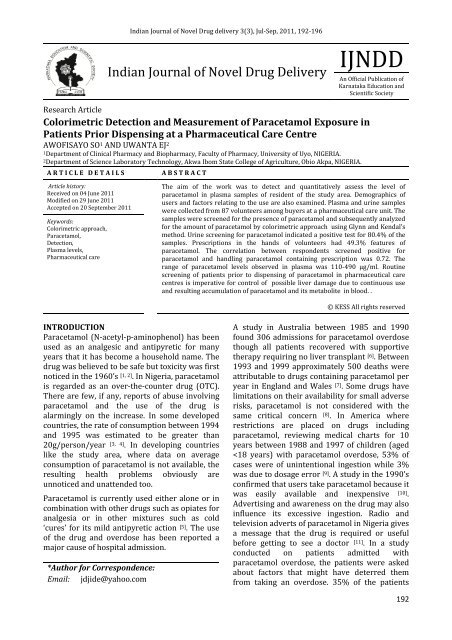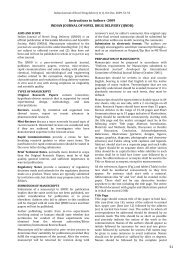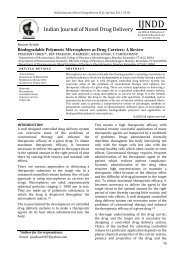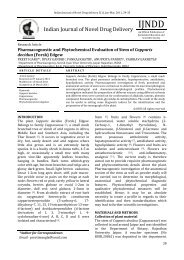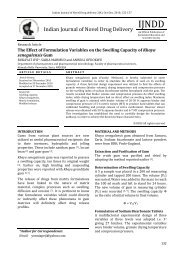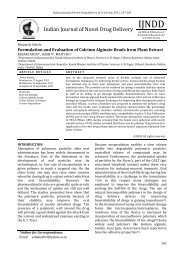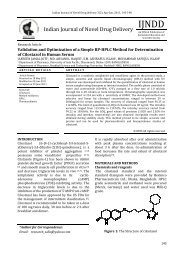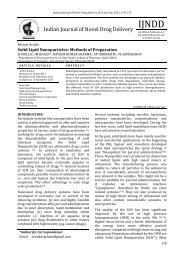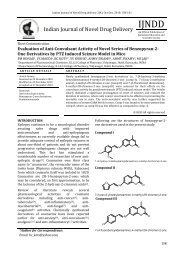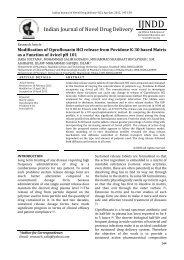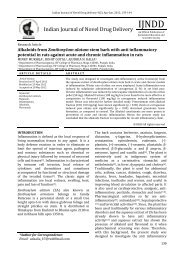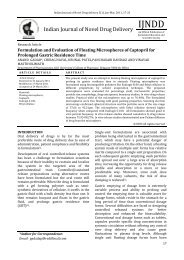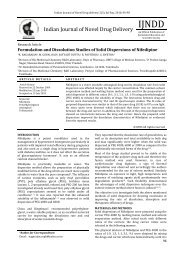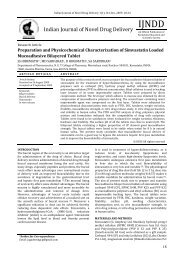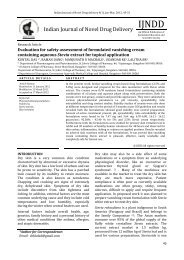Colorimetric Detection and Measurement of Paracetamol Exposure
Colorimetric Detection and Measurement of Paracetamol Exposure
Colorimetric Detection and Measurement of Paracetamol Exposure
Create successful ePaper yourself
Turn your PDF publications into a flip-book with our unique Google optimized e-Paper software.
Indian Journal <strong>of</strong> Novel Drug delivery 3(3), Jul-Sep, 2011, 192-196<br />
Indian Journal <strong>of</strong> Novel Drug Delivery<br />
IJNDD<br />
An Official Publication <strong>of</strong><br />
Karnataka Education <strong>and</strong><br />
Scientific Society<br />
Research Article<br />
<strong>Colorimetric</strong> <strong>Detection</strong> <strong>and</strong> <strong>Measurement</strong> <strong>of</strong> <strong>Paracetamol</strong> <strong>Exposure</strong> in<br />
Patients Prior Dispensing at a Pharmaceutical Care Centre<br />
AWOFISAYO SO 1 AND UWANTA EJ 2<br />
1Department <strong>of</strong> Clinical Pharmacy <strong>and</strong> Biopharmacy, Faculty <strong>of</strong> Pharmacy, University <strong>of</strong> Uyo, NIGERIA.<br />
2Department <strong>of</strong> Science Laboratory Technology, Akwa Ibom State College <strong>of</strong> Agriculture, Obio Akpa, NIGERIA.<br />
A R T I C L E D E T A I L S<br />
A B S T R A C T<br />
Article history:<br />
Received on 04 June 2011<br />
Modified on 29 June 2011<br />
Accepted on 20 September 2011<br />
Keywords:<br />
<strong>Colorimetric</strong> approach,<br />
<strong>Paracetamol</strong>,<br />
<strong>Detection</strong>,<br />
Plasma levels,<br />
Pharmaceutical care<br />
The aim <strong>of</strong> the work was to detect <strong>and</strong> quantitatively assess the level <strong>of</strong><br />
paracetamol in plasma samples <strong>of</strong> resident <strong>of</strong> the study area. Demographics <strong>of</strong><br />
users <strong>and</strong> factors relating to the use are also examined. Plasma <strong>and</strong> urine samples<br />
were collected from 87 volunteers among buyers at a pharmaceutical care unit. The<br />
samples were screened for the presence <strong>of</strong> paracetamol <strong>and</strong> subsequently analyzed<br />
for the amount <strong>of</strong> paracetamol by colorimetric approach using Glynn <strong>and</strong> Kendal’s<br />
method. Urine screening for paracetamol indicated a positive test for 80.4% <strong>of</strong> the<br />
samples. Prescriptions in the h<strong>and</strong>s <strong>of</strong> volunteers had 49.3% features <strong>of</strong><br />
paracetamol. The correlation between respondents screened positive for<br />
paracetamol <strong>and</strong> h<strong>and</strong>ling paracetamol containing prescription was 0.72. The<br />
range <strong>of</strong> paracetamol levels observed in plasma was 110-490 µg/ml. Routine<br />
screening <strong>of</strong> patients prior to dispensing <strong>of</strong> paracetamol in pharmaceutical care<br />
centres is imperative for control <strong>of</strong> possible liver damage due to continuous use<br />
<strong>and</strong> resulting accumulation <strong>of</strong> paracetamol <strong>and</strong> its metabolite in blood. .<br />
© KESS All rights reserved<br />
INTRODUCTION<br />
<strong>Paracetamol</strong> (N-acetyl-p-aminophenol) has been<br />
used as an analgesic <strong>and</strong> antipyretic for many<br />
years that it has become a household name. The<br />
drug was believed to be safe but toxicity was first<br />
noticed in the 1960’s [1, 2] . In Nigeria, paracetamol<br />
is regarded as an over-the-counter drug (OTC).<br />
There are few, if any, reports <strong>of</strong> abuse involving<br />
paracetamol <strong>and</strong> the use <strong>of</strong> the drug is<br />
alarmingly on the increase. In some developed<br />
countries, the rate <strong>of</strong> consumption between 1994<br />
<strong>and</strong> 1995 was estimated to be greater than<br />
20g/person/year [3, 4] . In developing countries<br />
like the study area, where data on average<br />
consumption <strong>of</strong> paracetamol is not available, the<br />
resulting health problems obviously are<br />
unnoticed <strong>and</strong> unattended too.<br />
<strong>Paracetamol</strong> is currently used either alone or in<br />
combination with other drugs such as opiates for<br />
analgesia or in other mixtures such as cold<br />
‘cures’ for its mild antipyretic action [5] . The use<br />
<strong>of</strong> the drug <strong>and</strong> overdose has been reported a<br />
major cause <strong>of</strong> hospital admission.<br />
*Author for Correspondence:<br />
Email: jdjide@yahoo.com<br />
A study in Australia between 1985 <strong>and</strong> 1990<br />
found 306 admissions for paracetamol overdose<br />
though all patients recovered with supportive<br />
therapy requiring no liver transplant [6] . Between<br />
1993 <strong>and</strong> 1999 approximately 500 deaths were<br />
attributable to drugs containing paracetamol per<br />
year in Engl<strong>and</strong> <strong>and</strong> Wales [7] . Some drugs have<br />
limitations on their availability for small adverse<br />
risks, paracetamol is not considered with the<br />
same critical concern [8]. In America where<br />
restrictions are placed on drugs including<br />
paracetamol, reviewing medical charts for 10<br />
years between 1988 <strong>and</strong> 1997 <strong>of</strong> children (aged<br />
Aw<strong>of</strong>isayo SO et al / Indian Journal <strong>of</strong> Novel Drug Delivery 3(3),Jul-Sep, 2011, 192-196<br />
would not have taken an overdose were it made<br />
a prescription only <strong>and</strong> 40% would have sought<br />
an alternative [12-15] .<br />
<strong>Paracetamol</strong> reduces the oxidized form <strong>of</strong> the<br />
COX enzyme, preventing it from forming proinflammatory<br />
chemicals. This leads to a reduced<br />
amount <strong>of</strong> Prostagl<strong>and</strong>in E2 in the CNS, thus<br />
lowering the hypothalamic set-point in the<br />
thermoregulatory centre.<br />
<strong>Paracetamol</strong> also modulates the endogenous<br />
cannabinoid system. <strong>Paracetamol</strong> is metabolized<br />
to AM404, a compound with several actions;<br />
most important, it inhibits the uptake <strong>of</strong> the<br />
endogenous cannabinoid/vanilloid an<strong>and</strong>amide<br />
by neurons [16] . An<strong>and</strong>amide uptake would result<br />
in the activation <strong>of</strong> the main pain receptor<br />
(nociceptor) <strong>of</strong> the body, the TRPV1 (older name:<br />
vanilloid receptor). Furthermore, AM404 inhibits<br />
sodium channels, as do the anesthetics lidocaine<br />
<strong>and</strong> procaine. Either <strong>of</strong> these actions by<br />
themselves has been shown to reduce pain, <strong>and</strong> a<br />
possible mechanism for paracetamol. However, it<br />
has been demonstrated that, after blocking<br />
cannabinoid receptors with synthetic<br />
antagonists, paracetamol's analgesic effects are<br />
prevented, suggesting its pain-relieving action<br />
involves activation <strong>of</strong> the endogenous<br />
cannabinoid system.<br />
The exact mechanism how COX is inhibited in<br />
various circumstances is still subject <strong>of</strong><br />
discussion. Because <strong>of</strong> differences in the activity<br />
<strong>of</strong> paracetamol, aspirin, <strong>and</strong> other NSAIDs, it has<br />
been postulated that further COX variants may<br />
exist. A recently discovered COX-1 splice variant<br />
termed COX-3 was considered to explain some <strong>of</strong><br />
the knowledge gap; however newer findings do<br />
not support the hypothesis that it plays any<br />
significant role in the functioning <strong>of</strong> paracetamol.<br />
<strong>Paracetamol</strong> hepatotoxicity is, by far, the most<br />
common cause <strong>of</strong> acute liver failure in both the<br />
United States <strong>and</strong> the United Kingdom.<br />
<strong>Paracetamol</strong> overdose results in more calls to<br />
poison control centers in the US than overdose <strong>of</strong><br />
any other pharmacological substance [17] . Signs<br />
<strong>and</strong> symptoms <strong>of</strong> paracetamol toxicity may<br />
initially be absent or vague. Untreated overdose<br />
can lead to liver failure <strong>and</strong> death within days.<br />
Treatment is aimed at removing the paracetamol<br />
from the body <strong>and</strong> replacing glutathione.<br />
Activated charcoal can be used to decrease<br />
absorption <strong>of</strong> paracetamol if the patient presents<br />
for treatment soon after the overdose. While the<br />
antidote, acetylcysteine, (also called N-<br />
acetylcysteine or NAC) acts as a precursor for<br />
glutathione, helping the body regenerate enough<br />
to prevent damage to the liver, a liver transplant<br />
is <strong>of</strong>ten required if damage to the liver becomes<br />
severe.<br />
The work was aimed at establishing a format for<br />
screening <strong>and</strong> assessing the level <strong>of</strong> paracetamol<br />
in the urine <strong>and</strong> plasma samples <strong>of</strong> buyers as to<br />
ascertain the extent <strong>of</strong> use <strong>of</strong> the drug <strong>and</strong><br />
possibly call for caution to the users prior to<br />
dispensing <strong>and</strong> restrictions through the<br />
regulatory authorities.<br />
EXPERIMENTAL MATERIALS<br />
Reagents<br />
Sodium hydroxide, sodium nitrite, hydrochloric<br />
acid, sulfamic acid, trichloroacetic acid <strong>and</strong><br />
ammonium hydroxide were analytical grade <strong>and</strong><br />
purchased from Sigma Chemicals, Germany.<br />
<strong>Paracetamol</strong> powder was a gift from May <strong>and</strong><br />
Baker Plc, USA.<br />
Method<br />
<strong>Detection</strong> <strong>of</strong> paracetamol in urine<br />
Urine samples were collected from 87 (62 males<br />
<strong>and</strong> 25 females) with mean age (32.7±8.2 <strong>and</strong><br />
22.7±10.1 years), buyers at a pharmaceutical<br />
care unit <strong>of</strong> a private pharmacy while 70<br />
volunteers (55 males <strong>and</strong> 15 females) with mean<br />
age (29.2±7.9 <strong>and</strong> 28.5±9.1years) consented to<br />
give 5ml <strong>of</strong> blood samples obtained by<br />
venipuncture.<br />
<strong>Paracetamol</strong>-cresol-ammonia test (PCAT) was<br />
used to detect the presence <strong>of</strong> paracetamol in the<br />
urine <strong>of</strong> the volunteers. 0.5 ml <strong>of</strong> urine was taken<br />
from the collected samples <strong>and</strong> 0.5 ml <strong>of</strong><br />
hydrochloric acid was added in a conical flask,<br />
allowed to st<strong>and</strong> for 10min <strong>and</strong> placed in a<br />
thermostated water bath at 100 o C. 2 drops <strong>of</strong> the<br />
mixture was taken into a beaker <strong>and</strong> 10 ml <strong>of</strong><br />
water, 1ml <strong>of</strong> 1% o-cresol <strong>and</strong> 4 ml <strong>of</strong> 2M<br />
ammonium hydroxide were added. The blue<br />
colour produced (if paracetamol was present)<br />
was compared with the st<strong>and</strong>ard solutions <strong>of</strong><br />
paracetamol prepared.<br />
Calibration curve determination<br />
The purity <strong>of</strong> the paracetamol powder was<br />
checked by melting pointbefore the assay was<br />
determined by the BP <strong>of</strong>ficial method. 1g <strong>of</strong><br />
paracetamol powder was dissolved in 10ml <strong>of</strong><br />
dehydrated alcohol <strong>and</strong> diluted to 1L with water<br />
to give a stock solution <strong>of</strong> 0.1%. 20 ml aliquots <strong>of</strong><br />
normal plasma were pipette into 5 beakers <strong>and</strong><br />
100, 200,400,600, <strong>and</strong> 800µL <strong>of</strong> the stock<br />
solution were added to give 50, 100,200,300 <strong>and</strong><br />
193
Aw<strong>of</strong>isayo SO et al / Indian Journal <strong>of</strong> Novel Drug Delivery 3(3),Jul-Sep, 2011, 192-196<br />
400µL <strong>of</strong> the drug in solution respectively. The<br />
absorbance <strong>of</strong> the various concentrations was<br />
determined at 254nm. Correlation <strong>of</strong> the<br />
concentration versus absorbance obtained for<br />
calibration curve determination <strong>and</strong> Glynn <strong>and</strong><br />
Kendal’s method gave a regression <strong>of</strong> 0.9987.<br />
<strong>Colorimetric</strong> determination <strong>of</strong> paracetamol in<br />
plasma<br />
The colorimetric assay performed was based on<br />
Glynn <strong>and</strong> Kendal’s method <strong>of</strong> paracetamol<br />
determination in plasma.<br />
0.5 ml <strong>of</strong> plasma samples collected was pipette<br />
into a centrifuge tube containing 10ml <strong>of</strong> 15%<br />
trichloroacetic acid <strong>and</strong> vortex mixed for 3 min<br />
<strong>and</strong> centrifuged. The clear supernatant obtained<br />
was decanted into a 10ml tube containing 0.5 ml<br />
6N hydrochloric acid as 0.4 ml <strong>of</strong> sodium nitrite<br />
was added drop wise to the resulting solution.<br />
The content was allowed to st<strong>and</strong> for 2 min to<br />
allow the pr<strong>of</strong>use liberation <strong>of</strong> nitrous acid. 15%<br />
<strong>of</strong> sulfamic acid was added to neutralize the<br />
remaining nitrous acid in the reaction mixture<br />
before the addition <strong>of</strong> 2.5ml <strong>of</strong> 15%sodium<br />
hydroxide. The absorbance <strong>of</strong> the various<br />
samples was taken at 430 nm against a control <strong>of</strong><br />
the reagent blank <strong>of</strong> water.<br />
O<br />
N<br />
H<br />
OH<br />
Figure 1: Structure <strong>of</strong> paracetamol<br />
RESULTS<br />
The absolute purity <strong>of</strong> the paracetamol powder<br />
was 99.81%. Beer’s law was valid over the<br />
concentration range used in the calibration<br />
giving a linearity <strong>of</strong> concentration versus<br />
absorbance as expressed in Fig 1.<br />
The screening <strong>of</strong> the urine samples gave the<br />
detection <strong>of</strong> paracetamol levels within the ranges<br />
as expressed in Table1 as made by visual<br />
observation against pre-constituted st<strong>and</strong>ard<br />
solutions <strong>of</strong> paracetamol. A total <strong>of</strong> 59 samples<br />
gave distinct blue colour indicative <strong>of</strong><br />
appreciable levels <strong>of</strong> paracetamol in blood while<br />
17 gave negative result. The calibration plot <strong>of</strong><br />
the st<strong>and</strong>ard paracetamol solutions <strong>and</strong> the<br />
correlation coefficient for the curve are<br />
expressed in Fig. 2. The statistics <strong>of</strong> the mean<br />
plasma concentration (Cp) <strong>of</strong> paracetamol in<br />
males <strong>and</strong> females with the st<strong>and</strong>ard deviation<br />
<strong>and</strong> coefficient <strong>of</strong> variation are expressed in<br />
Table 1.<br />
Table 1: The statistics <strong>of</strong> volunteers with<br />
positive paracetamol screening<br />
Sex<br />
Mean<br />
paracetamol<br />
level<br />
Number <strong>of</strong><br />
samples<br />
St<strong>and</strong>ard<br />
Deviation<br />
Male 292.33 55 11.72<br />
Female 274.00 15 9.70<br />
Mean difference= 18.33 <strong>and</strong> 2 tail P value =0.5494<br />
<strong>Paracetamol</strong> concentration mcg/ml<br />
Figure 2: The calibration curve <strong>of</strong> absorbance<br />
<strong>and</strong> concentration <strong>of</strong> paracetamol<br />
DISCUSSION<br />
For the purpose <strong>of</strong> pharmaceutical care an<br />
attached quality control or drug monitor<br />
laboratory may be required within the<br />
pharmaceutical premises to aid a rapid<br />
pharmaceutical care intervention. Various assay<br />
methods have been documented for paracetamol<br />
with varying cost <strong>and</strong> sometimes involving<br />
technical skill <strong>and</strong> equipment. Titrimetric<br />
determination <strong>of</strong> paracetamol with cerium (IV)<br />
in acidic media using 1, 10- phenanthroline-iron<br />
(II) complex (ferroin) (BP <strong>of</strong>ficial method) may<br />
be unsuitable for paracetamol in biological fluids<br />
because <strong>of</strong> presence <strong>of</strong> interfering substances.<br />
Glynn <strong>and</strong> Kendal’s method gives more reliable<br />
measure <strong>of</strong> the free drug <strong>and</strong> is specific enough<br />
to rule out interfering drugs like caffeine,<br />
indomethacin, <strong>and</strong> other similar drugs.<br />
<strong>Colorimetric</strong> assay for paracetamol is accurate in<br />
aqueous <strong>and</strong> plasma samples over a clinically<br />
observable range <strong>of</strong> paracetamol concentrations.<br />
The pattern <strong>of</strong> use <strong>of</strong> paracetamol in the study<br />
area revealed that the observation showed that<br />
paracetamol comes to mind when there is any<br />
sign relating to the consumer’s perception <strong>of</strong><br />
need for the drug. The plasma levels <strong>of</strong><br />
paracetamol in females is not significantly higher<br />
than in males (P
Aw<strong>of</strong>isayo SO et al / Indian Journal <strong>of</strong> Novel Drug Delivery 3(3),Jul-Sep, 2011, 192-196<br />
Table 2: Analysis <strong>of</strong> prescriptions presented for features <strong>of</strong> paracetamol<br />
Parameters<br />
Male<br />
Female<br />
Total<br />
N(62)<br />
N(25)<br />
N( 87)<br />
Total Prescriptions 62 25 87<br />
Prescriptions containing paracetamol 21 10 31<br />
Prescriptions containing paracetamol <strong>and</strong> h<strong>and</strong>ler having paracetamol level >300<br />
µg/ml in plasma<br />
Number <strong>of</strong> urine samples screened positive for paracetamol <strong>and</strong> plasma level<br />
less than 100 µg/ml<br />
8 5 13<br />
6 4 10<br />
Levels <strong>of</strong> paracetamol above 200mcg/ml as<br />
observed in 80% <strong>of</strong> the study population as at<br />
the time <strong>of</strong> patronage <strong>and</strong> the fact that 37.5% <strong>of</strong><br />
the prescriptions still contained the drug may be<br />
an indication that the blood level is on the rise in<br />
the study area. Chronic use <strong>of</strong> paracetamol can<br />
lead to liver damage [18] . The risk <strong>of</strong> liver damage<br />
due to paracetamol can be predicted from<br />
plasma paracetamol concentration. Screening <strong>of</strong><br />
urine for presence <strong>of</strong> paracetamol levels can be a<br />
value–added service <strong>and</strong> by extension a form <strong>of</strong><br />
pharmaceutical care in an environment where<br />
the regulation on sales <strong>of</strong> over the counter drugs<br />
is very relaxed. The distribution observed in this<br />
study gives an impression that paracetamol is<br />
considered a household commodity. <strong>Paracetamol</strong><br />
poisoning is heard in Australia, the United States<br />
<strong>and</strong> U.K. with statistics on its attendant liver<br />
failure cases <strong>and</strong> other forms <strong>of</strong> intervention.<br />
Such data is not available in developing countries<br />
like Nigeria but consumption <strong>of</strong> the drugs does<br />
not appear different from what obtains in other<br />
part <strong>of</strong> the world. Very high <strong>and</strong> toxic levels <strong>of</strong><br />
paracetamol in plasma can be noted through this<br />
method <strong>and</strong> the use <strong>of</strong> n-acetyl cysteine (NAC) to<br />
arrest the situation before it precipitates serious<br />
toxicity <strong>and</strong> the consequent signs [19] .<br />
CONCLUSION<br />
The annexing or introduction <strong>of</strong> a minilaboratory<br />
to government pharmacy units <strong>and</strong><br />
community drug centres can be <strong>of</strong> great<br />
advantage in monitoring <strong>and</strong> early detection <strong>of</strong><br />
overuse <strong>of</strong> drugs that can lead to possible<br />
accumulation <strong>and</strong> toxicity associated signs.<br />
LIMITATION<br />
The screening for paracetamol <strong>and</strong><br />
determination <strong>of</strong> plasma paracetamol using<br />
Glynn <strong>and</strong> Kendal’s method involves the<br />
liberation <strong>of</strong> nitrous acid which requires enough<br />
laboratory space <strong>and</strong> fume hood which may<br />
hinder routine performance <strong>of</strong> the<br />
determination. The method also requires a<br />
spectrophotometer that may be beyond the<br />
reach <strong>of</strong> a starter unit where this sort <strong>of</strong><br />
determination as an extension <strong>of</strong> pharmaceutical<br />
care is required.<br />
REFERENCES<br />
[1] Thomas JS <strong>and</strong> Prescott LF. Liver damage<br />
<strong>and</strong> impaired glucose tolerance after<br />
paracetamol overdosage. Br Med J. 1966;<br />
(2): 506-7<br />
[2] D<strong>and</strong>son DGD <strong>and</strong> Eastham WN. Acute<br />
Liver necrosis following overdose <strong>of</strong><br />
<strong>Paracetamol</strong>. Br Med J. 1966; 2: 497-9.<br />
[3] Prescott LF. <strong>Paracetamol</strong> (Acetaminophen):<br />
A Critical Bibliography Review, 1 st ed:<br />
London Taylor <strong>and</strong> Saviour, 1996.<br />
[4] Spooner JB <strong>and</strong> Harney JG. The History <strong>and</strong><br />
usage <strong>of</strong> paracetamol. J. Int. Med. Res. 1976.<br />
4:1-6<br />
[5] Gow PJ, Smallnovd RA, Angue PW.<br />
<strong>Paracetamol</strong> overdose in a liver<br />
transplantation center: An 8-years<br />
experience J. Restroenlent Hepatial 1999;<br />
14:817-21.<br />
[6] Mavin AJ, Wendon J, Williams R. A 7-years<br />
experience <strong>of</strong> severe acetaminophen<br />
induced hepatotoxicity (1987-1993).<br />
Gastroenterology 1995; 109; 1907-1917.<br />
[7] Atete Z. <strong>Paracetamol</strong> related deaths in<br />
Engl<strong>and</strong> <strong>and</strong> Wales, 1993-97. Health stat Q<br />
2000; 7; 5-9.<br />
[8] Pratt CM, Herolz RP, Ellis BE, Crowell SP,<br />
Lour W, Moye L. Risk <strong>of</strong> developing life<br />
threatening ventricular arrhythmias<br />
associated with tefebnadine in companion<br />
with over-the-counter antihistamines,<br />
ibupr<strong>of</strong>en <strong>and</strong> demastine. Am J Cardiol<br />
1994; 73:346-52.<br />
[9] Hawton K, Ware C, Mistry H, Hewitt J,<br />
Kingsbury S, Robert D, Weitizer H. why<br />
patients choose <strong>Paracetamol</strong> for self<br />
195
Aw<strong>of</strong>isayo SO et al / Indian Journal <strong>of</strong> Novel Drug Delivery 3(3),Jul-Sep, 2011, 192-196<br />
paining <strong>and</strong> their knowkedge <strong>of</strong> its<br />
dangers. Br. Med. J. 1995: 310:164.<br />
[10] Cormor S, Decks JJ, Hawton K, Simkin S,<br />
Keen A, Altman DG, Philo G, Bulstrode C.<br />
Effects <strong>of</strong> a drug overdose in a television<br />
drama on knowledge <strong>of</strong> specific dangers <strong>of</strong><br />
self-poisoning: population based surveys:<br />
Br. Med J. 1999: 318:978-9.<br />
[11] Hawton K, Ware C, Misty H, Hewitt J,<br />
Kingsbury S, Robert D, Weithizel H.<br />
<strong>Paracetamol</strong> self poisoning characteristics,<br />
prevention <strong>and</strong> harm reduction. Br. J. Psych<br />
1996; 168:43-8<br />
[12] Gunnel, D. Hawton K. Murray V, Garnier R,<br />
Bismulth Figg J, Simkin S. Use <strong>of</strong><br />
paracetamol for suicide <strong>and</strong> non-fatal<br />
poisoning in the UK <strong>and</strong> France: are<br />
restrictions on availability justified? J.<br />
Epidermal Comm Health 1997: 51:175-9<br />
[13] Prince M, Thomas SHL, James OFW, Kudson<br />
M Reduction in incidence <strong>of</strong> severe<br />
<strong>Paracetamol</strong> poisoning. Lancet 000: 355:<br />
2047-8.<br />
[14] Turnil JL, Burroughs AK, Moore KP. Change<br />
in occurrence <strong>of</strong> <strong>Paracetamol</strong> overdose in<br />
UK after introduction <strong>of</strong> blister pains.<br />
Lancet 2000, 355:2048 – 9.<br />
[15] Sheen CL, Dillon JF, Bateman DN, Sampson<br />
K, Mac Donald TM. The effect on toxicity on<br />
reducing the size <strong>of</strong> available <strong>Paracetamol</strong><br />
pack sizes Gut 2001 48 (Suppl. 1) A105.<br />
[16] Hogestatt ED, Jonsson BA, Ermund A.<br />
Conversion <strong>of</strong> acetaminophen to the<br />
bioactive N-acylphenolamine AM404 via<br />
fatty acid amide hydrolase dependent<br />
arachidonic acid conjugation in the nervous<br />
system. J Biol. Chem.2005; 280 (36):31405-<br />
12.<br />
[17] Khashab M, Tecor AJ, Kwo PY.<br />
Epiidemiology <strong>of</strong> acute liver failure. Curr<br />
Gastroenterol Rep. 2007; 9 (1): 66-73.<br />
[18] Dally FF, Fountain JS, Murray L, Graudins A,<br />
Buckley NA. Guidelines for the<br />
management <strong>of</strong> paracetamol poisoning in<br />
Australia <strong>and</strong> New Zeal<strong>and</strong>- explanation<br />
<strong>and</strong> elaboration.A consensus statement for<br />
clinical toxicologists consulting to the<br />
Australasian poisons information centres.<br />
Med J Aust. 2008; 185 (5):296-301.<br />
[19] Graham GG,Scott KF. Mechanism <strong>of</strong> action<br />
<strong>of</strong> paracetamol. American Journal <strong>of</strong><br />
therapeutics. 2005;12(1): 46-55.<br />
196


